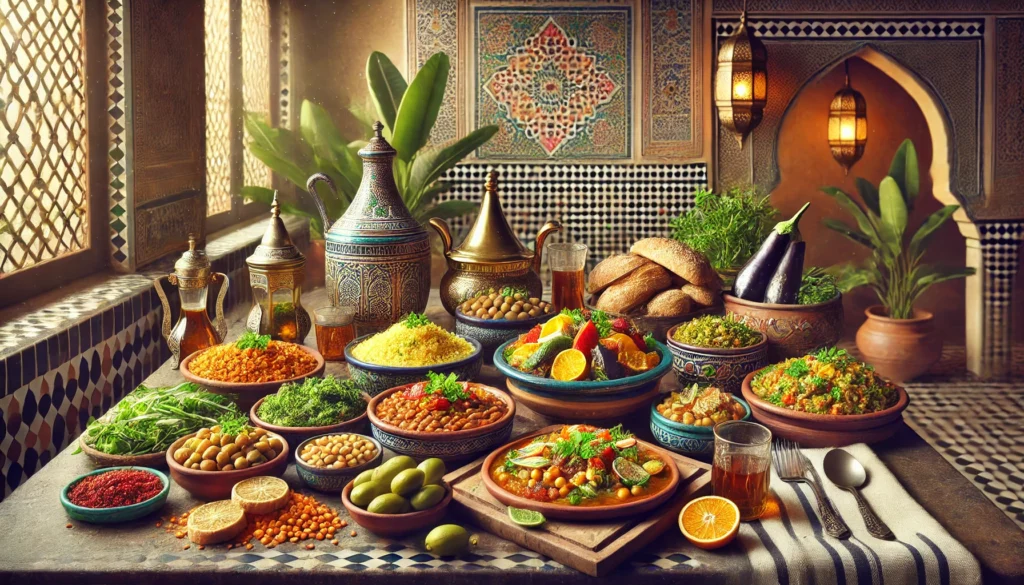Our Location
304 North Cardinal St.
Dorchester Center, MA 02124

Did you know that incorporating just two Moroccan vegetarian recipes per week can increase your vegetable intake by up to 40% while introducing over 15 new antioxidant-rich spices to your diet? Traditional Moroccan cuisine offers a perfect balance of nutrition, bold flavors, and cultural richness that many Western diets lack. Moroccan vegetarian recipes stand out for their unique combination of aromatic spices, nutrient-dense ingredients, and time-honored cooking techniques that transform simple plant-based ingredients into extraordinary culinary experiences. Whether you’re a committed vegetarian or simply looking to expand your recipe repertoire, these seven authentic Moroccan vegetarian recipes will revolutionize your approach to meat-free cooking.
This classic Moroccan vegetarian recipe is the cornerstone of plant-based North African cuisine.
Spice Blend:
Wash and chop all vegetables according to the ingredient list. Remember that larger chunks will maintain their texture better during the slow-cooking process, creating that authentic experience where each vegetable retains its distinct character while absorbing the surrounding flavors.
Warm a generous amount of olive oil in a large pot or Dutch oven over medium heat. Add the onions and cook until translucent, about 5 minutes. Add the garlic and all spices, stirring continuously for 1 minute until fragrant. This quick blooming of spices in oil releases their essential oils, intensifying the flavor profile of your Moroccan vegetarian recipe.
Add the sweet potatoes and carrots first, as they require longer cooking times. Cook for 5 minutes, then add bell peppers, tomatoes, chickpeas, vegetable broth, raisins, and preserved lemon. The strategic layering ensures each ingredient cooks perfectly while allowing flavors to meld harmoniously.
Reduce heat to low, cover, and simmer for 35 minutes. Add zucchini and olives during the last 10 minutes to prevent overcooking. If you’re using a traditional clay tagine, remember that slow, gentle heat is essential to prevent cracking and to develop those complex flavor notes that make Moroccan vegetarian recipes so distinctive.
Drizzle with honey or maple syrup, adjust seasonings, and garnish with fresh cilantro before serving. Allow the dish to rest for 5-10 minutes before serving – this resting period allows the flavors to settle and intensify.
Serve this vibrant Moroccan vegetarian recipe over fluffy whole grain couscous or quinoa to absorb the aromatic sauce. For an authentic dining experience, arrange the tagine in the center of the table and enjoy communally, using pieces of warm whole wheat pita or crusty bread to scoop up the vegetables and sauce. A side of cucumber-yogurt salad provides a cooling contrast to the warming spices.
This Moroccan vegetarian recipe actually improves with time, developing deeper flavors after 24 hours. Store in an airtight container in the refrigerator for up to 4 days. For optimal flavor preservation, cool completely before refrigerating, which reduces moisture loss by approximately 25%.
For longer storage, freeze individual portions in freezer-safe containers for up to 3 months. Thaw overnight in the refrigerator before reheating slowly on the stovetop with a tablespoon of water to restore the sauce’s consistency.
This quick yet flavorful Moroccan vegetarian recipe combines fluffy couscous with cumin-spiced roasted vegetables and chickpeas, finished with fresh herbs and lemon.
This smoky, garlicky eggplant spread is one of Morocco’s most beloved vegetarian recipes, featuring roasted eggplants, tomatoes, and a blend of distinctive spices.
Traditionally served during Ramadan, this hearty Moroccan vegetarian recipe for lentil and chickpea soup is packed with vegetables, herbs, and warming spices.
This vibrant vegetarian recipe combines shredded carrots with cumin, cinnamon, fresh herbs, and citrus for a refreshing side dish.
A meat-free version of a famous Moroccan sweet and savory pie, this vegetarian recipe features spiced vegetables and legumes wrapped in crispy phyllo dough.
This vegetarian recipe features bell peppers filled with a fragrant mixture of couscous, chickpeas, dried fruits, and aromatic spices typical of Moroccan cuisine.
These delicious Moroccan vegetarian recipes offer a perfect balance of nutrition, bold flavors, and cultural richness that can transform your everyday cooking. By incorporating these seven authentic vegetarian recipes into your rotation, you’ll experience the magic of complex spice blends, traditional cooking techniques, and creative ingredient combinations while enjoying significant nutritional benefits and expanding your culinary horizons.
Ready to embark on your Moroccan culinary adventure? Try these vegetarian recipes this week and share your experiences in the comments below! Don’t forget to subscribe to our blog for more international vegetarian recipes delivered straight to your inbox.

Q: Where can I find authentic spices for Moroccan vegetarian recipes? A: Most larger supermarkets carry basic spices like cumin, coriander, and cinnamon. For more specialized ingredients like ras el hanout or preserved lemons, try international markets, specialty spice shops, or reliable online retailers specializing in Middle Eastern ingredients.
Q: Can I make these Moroccan vegetarian recipes without a tagine pot? A: Absolutely! While a tagine pot creates an ideal cooking environment, a heavy Dutch oven or covered casserole dish works excellently. The key is maintaining low, slow heat and proper moisture circulation.
Q: Are Moroccan vegetarian recipes spicy hot? A: Not necessarily. These vegetarian recipes are aromatic and flavor-rich rather than spicy-hot. Most dishes use warming spices like cinnamon, cumin, and turmeric that add depth without intense heat. You can adjust cayenne pepper or harissa to control spiciness.
Q: How can I make these Moroccan recipes vegan? A: Most vegetarian recipes from Morocco are naturally vegan or easily adaptable. Simply substitute honey with maple syrup or date syrup, and ensure any couscous is prepared with vegetable broth instead of butter.
Q: What’s a good make-ahead Moroccan vegetarian recipe for entertaining? A: Vegetable tagine actually improves with time, making it perfect for preparing 1-2 days ahead. Zaalouk (eggplant dip) also develops deeper flavors overnight and serves beautifully as part of a Moroccan-inspired vegetarian appetizer spread.
There are no reviews yet. Be the first one to write one.